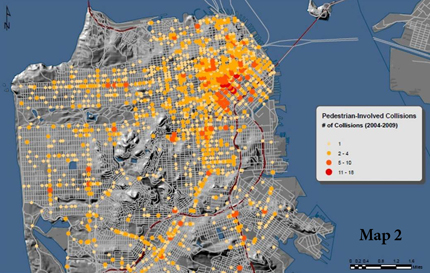by Mari Hunter
Long time Hayes Valley resident and member of the San Francisco Pedestrian Safety Advisory Committee (PSAC) John Alex Lowell presented the PSAC Annual Report during the Hayes Valley Neighborhood Association meeting in May. John’s involvement with PSAC and his work on the Report was not only a civic contribution but it is also personal—John is a survivor of a pedestrian collision from 10 years ago.
One hundred percent of all trips have a pedestrian component and 20% of all trips in San Francisco are entirely pedestrian trips. From 2005 to 2008 there were over 3,500 pedestrian collisions which totaled $74.3 million, 76% of which was paid for with public health care funds. To initiate a movement that would address these statistics—one that would identify the who, what, where, how and why, PSAC members researched and worked with numerous City departments (e.g. Municipal Transportation Agency, Planning Department, Department of Public Health, etc) and created a report that provided a baseline of the existing pedestrian environment; reviewing the policy, engineering/design, data, enforcement, and health & education. The report also identified a number of recommendations for each of the five components—key recommendations include:
1. Develop and implement observational studies to monitor rights-of way and other traffic code violations, by and of pedestrians, bicycles, and wheelchairs to identify hotspots.
2. Fines for traffic-related offenses that endanger pedestrians should be increased to an appropriate level and a citywide effort to enforce pedestrian and road safety laws should be made.
3. Police, health, transportation and planning data shall interface.
4. Police collision data shall have the capacity to be accessed in real-time by all transportation and health agencies with prior approval.
5. Identify a funding source to establish a pedestrian information registry for all pedestrian-related projects, studies, and activities.
Since the committee started its work on the Annual Report, which was presented to the Board of Supervisor’s City Operations and Neighborhood Services Committee in April, several other pedestrian safety related efforts have been initiated, namely WalkFirst SF, spearheaded by the Department of Public Health and the Planning Department; former Mayor Newsom’s directive forming a Pedestrian Safety Task Force; and efforts by Supervisor Kim (District Six) including a pedestrian safety hearing that was held in April.
District Six tops San Francisco’s most dangerous pedestrian regions, followed closely by the Financial District. One might expect these two locations to be hot spots for pedestrian accidents given the density of pedestrian activity (see Map 1), but also more residential areas like Hayes Valley have a disproportionate number of pedestrian collisions (see Map 2 for collision data), likely due in part to traffic along major arterials connecting to Highway 101.


Data has indicated that the geographic imbalance may be attributed to heavier local traffic and density of residential and employment centers but also socioeconomic characteristics including communities of low-income, minorities, and the youth and elderly.
This recent surge to improve pedestrian safety is just the beginning; there is significant work to be done so residents and visitors feel safe. Fortunately groups such as PSAC, Walk SF, the Pedestrian Safety Task Force and all of the city departments that influence the pedestrian environment are working to curb these preventable collisions and costs in a way that is both equitable and cost-effective. For the full report please visit https://sfmta.securesites.net/cms/cpdsafe/19509.html
